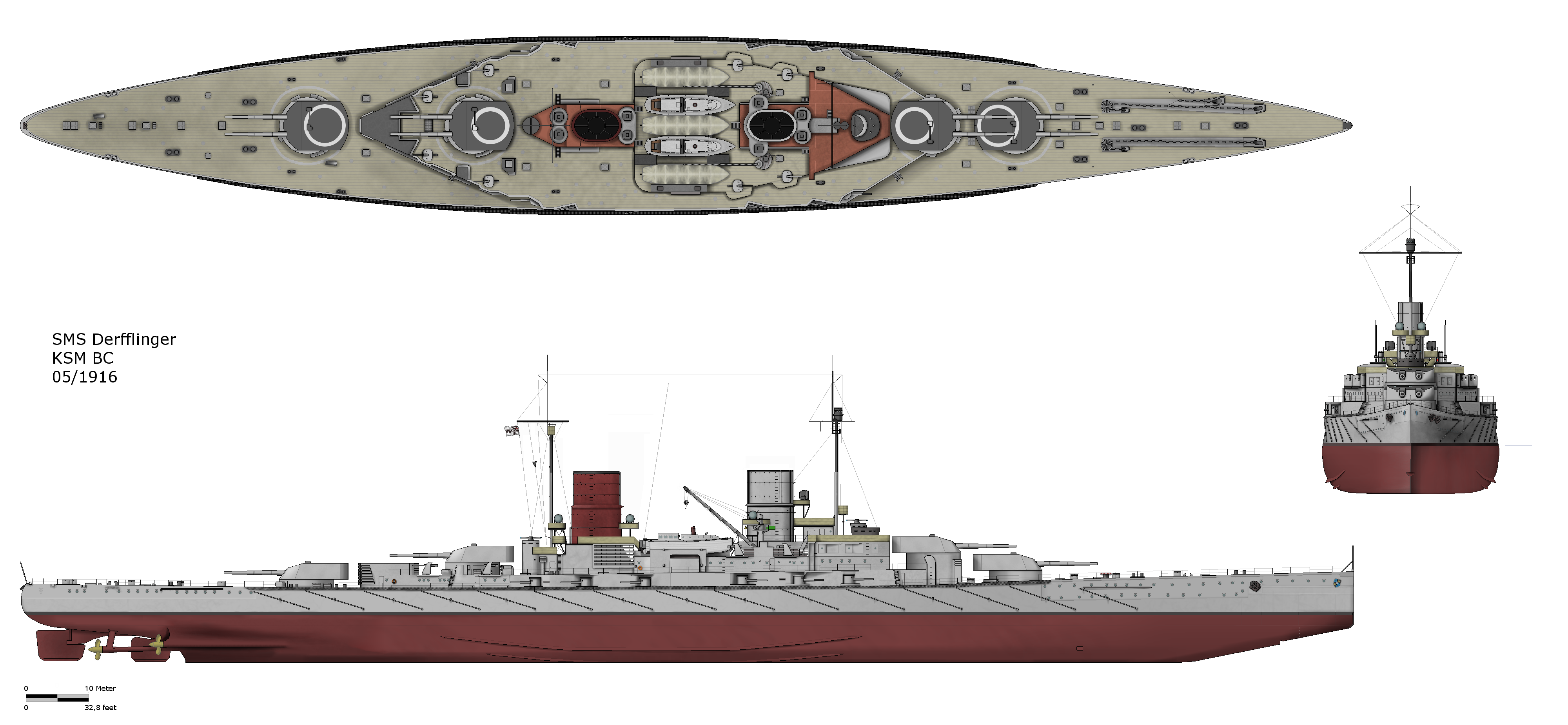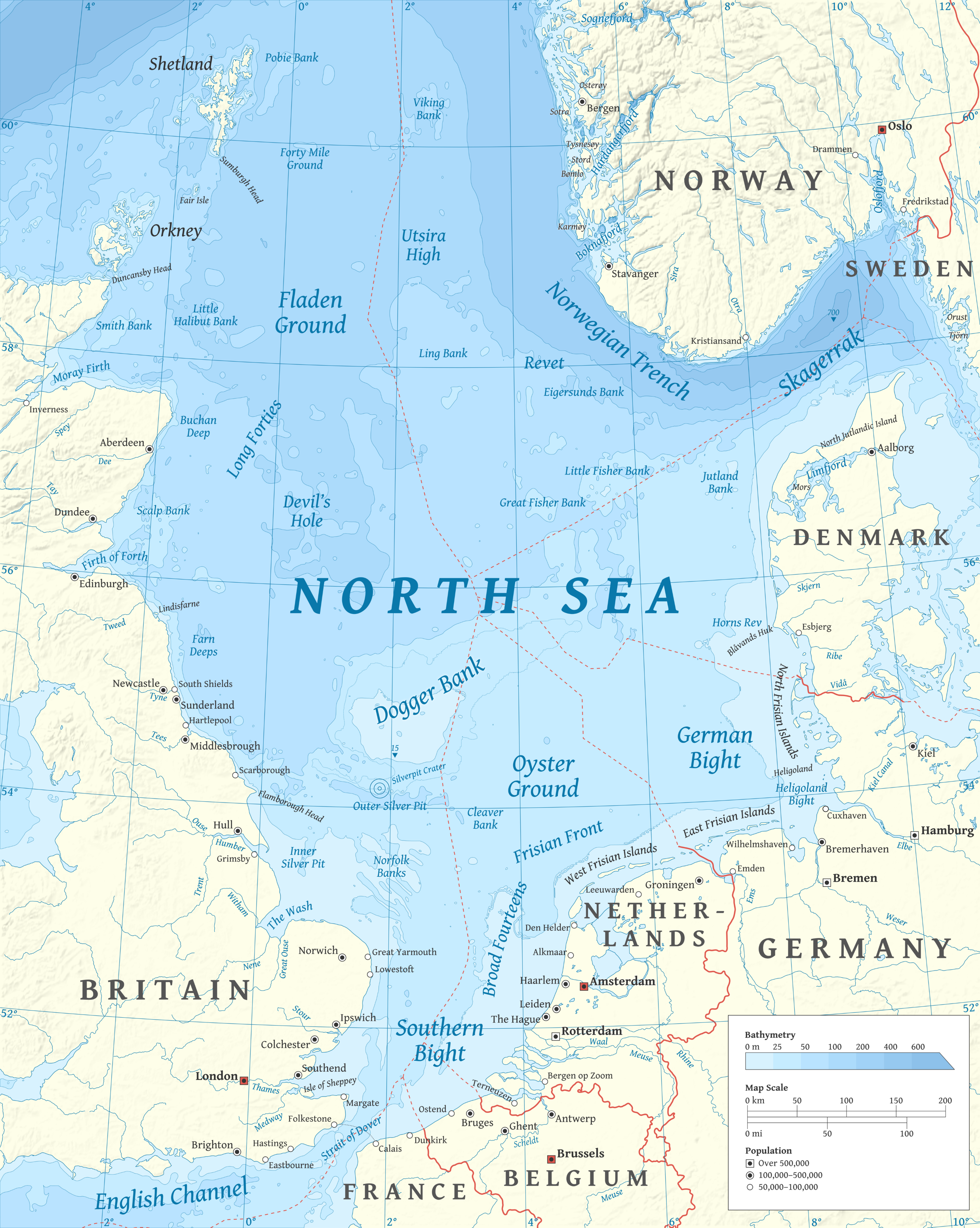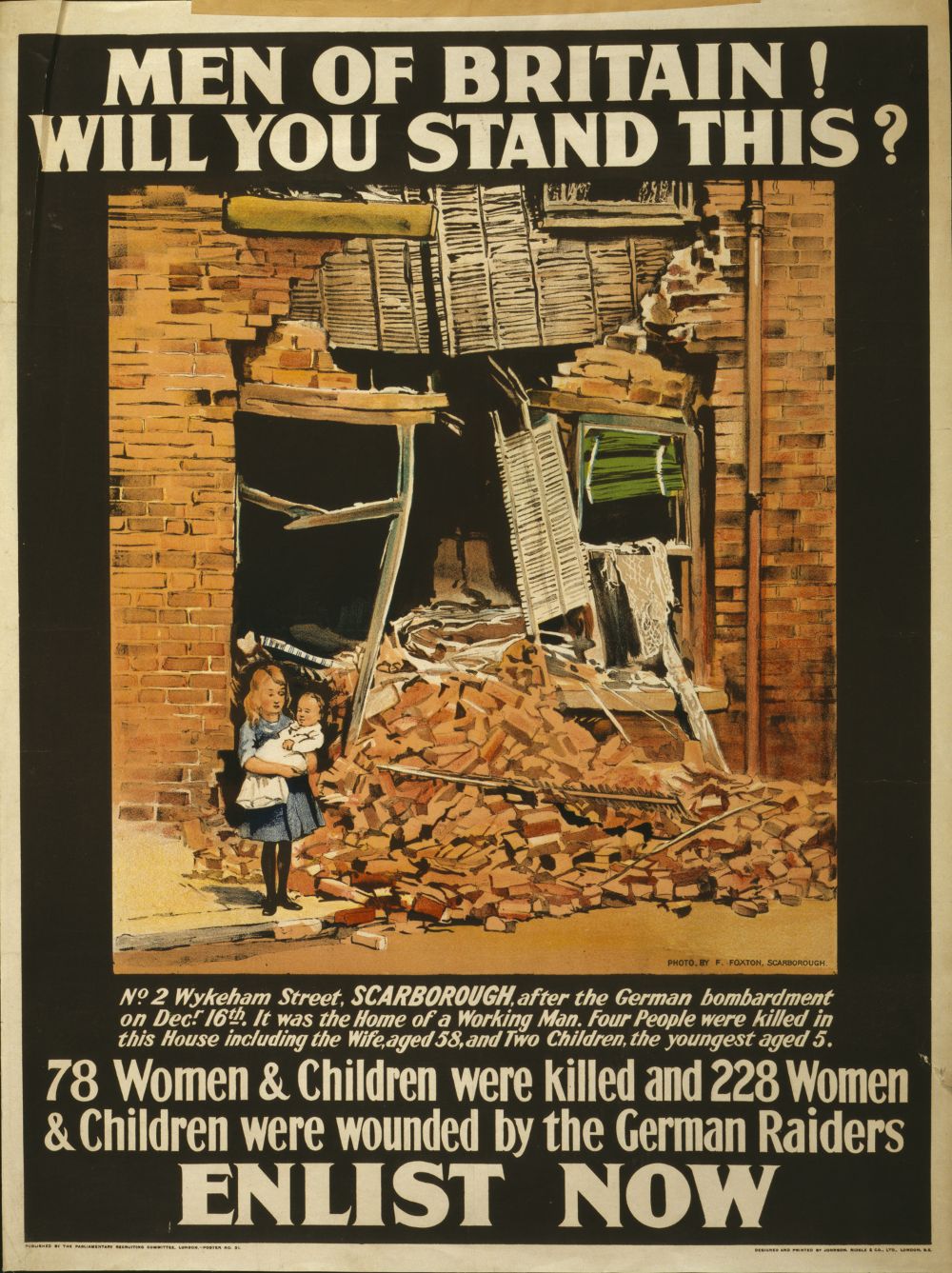|
SMS Derfflinger
SMS was a battlecruiser of the German Empire, German (Imperial Navy) built in the early 1910s during the Anglo-German naval arms race. She was the lead ship of her ship class, class of three ships; her sister ships were and . The s were larger and featured significant improvements over the previous German battlecruisers, carrying larger guns in a more efficient superfiring arrangement. was armed with a main battery of eight guns, compared to the guns of earlier battlecruisers. She had a top speed of and carried heavy protection, including a thick belt armor, armored belt. was completed shortly after the outbreak of World War I in 1914; after entering service, she joined the other German battlecruisers in I Scouting Group of the High Seas Fleet, where she served for the duration of the conflict. As part of this force, she took part in numerous operations in the North Sea, including the Raid on Scarborough, Hartlepool and Whitby in December 1914, the Battle of Dogger Bank ... [...More Info...] [...Related Items...] OR: [Wikipedia] [Google] [Baidu] |
German Empire
The German Empire (),Herbert Tuttle wrote in September 1881 that the term "Reich" does not literally connote an empire as has been commonly assumed by English-speaking people. The term literally denotes an empire – particularly a hereditary empire led by an emperor, although has been used in German to denote the Roman Empire because it had a weak hereditary tradition. In the case of the German Empire, the official name was , which is properly translated as "German Empire" because the official position of head of state in the constitution of the German Empire was officially a "presidency" of a confederation of German states led by the King of Prussia who would assume "the title of German Emperor" as referring to the German people, but was not emperor of Germany as in an emperor of a state. –The German Empire" ''Harper's New Monthly Magazine''. vol. 63, issue 376, pp. 591–603; here p. 593. also referred to as Imperial Germany, the Second Reich, as well as simply Germany, ... [...More Info...] [...Related Items...] OR: [Wikipedia] [Google] [Baidu] |
Anglo-German Naval Arms Race
The arms race between Great Britain and Germany that occurred from the last decade of the nineteenth century until the advent of World War I in 1914 was one of the intertwined causes of that conflict. While based in a bilateral relationship that had worsened over many decades, the arms race began with a plan by German Admiral Alfred von Tirpitz in 1897 to create a fleet in being to force Britain to make diplomatic concessions; Tirpitz did not expect the Imperial German Navy to defeat the Royal Navy. With the support of Kaiser Wilhelm II, Tirpitz began passing a series of laws to construct an increasing number of large surface warships. The construction of in 1906 prompted Tirpitz to further increase the rate of naval construction. While some British observers were uneasy at German naval expansion, alarm was not general until Germany's naval bill of 1908. The British public and political opposition demanded that the Liberal government meet the German challenge, resulting in th ... [...More Info...] [...Related Items...] OR: [Wikipedia] [Google] [Baidu] |
Bombardment Of Yarmouth And Lowestoft
The Bombardment of Yarmouth and Lowestoft, often referred to as the Lowestoft Raid, was a naval battle fought during the First World War between the German Empire and the British Empire in the North Sea. The German fleet sent a battlecruiser squadron with accompanying cruisers and destroyers, commanded by Rear Admiral Friedrich Boedicker, to bombard the coastal ports of Yarmouth and Lowestoft. Although the ports had some military importance, the main aim of the raid was to entice defending ships to sail, which could then be picked off, either by the battlecruiser squadron or by the full High Seas Fleet, which was stationed at sea ready to intervene. The result was inconclusive: nearby British forces were too small to challenge the German force and largely kept clear of the German battlecruisers, the German ships withdrew before the British fast response battlecruiser squadron or the Grand Fleet could arrive. Background In February 1916, Admiral Reinhard Scheer became comman ... [...More Info...] [...Related Items...] OR: [Wikipedia] [Google] [Baidu] |
Battle Of Dogger Bank (1915)
The Battle of Dogger Bank was a naval engagement during the First World War that took place on 24 January 1915 near the Dogger Bank in the North Sea, between squadrons of the British Grand Fleet and the (High Seas Fleet). The British had intercepted and decoded German wireless transmissions, gaining advance knowledge that a German raiding squadron was heading for Dogger Bank and ships of the Grand Fleet sailed to intercept the raiders. The British surprised the smaller and slower German squadron, which fled for home. During a stern chase lasting several hours, the British caught up with the Germans and engaged them with long-range gunfire. The British disabled , the rearmost German ship, and the Germans put the British flagship out of action. Due to inadequate signalling, the remaining British ships stopped the pursuit to sink ''Blücher''; by the time the ship had been sunk, the rest of the German squadron had escaped. The German squadron returned to harbour, with some ship ... [...More Info...] [...Related Items...] OR: [Wikipedia] [Google] [Baidu] |
Raid On Scarborough, Hartlepool And Whitby
The Raid on Scarborough, Hartlepool and Whitby on 16 December 1914 was an attack by the Imperial German Navy on the British ports of Scarborough, Hartlepool, West Hartlepool and Whitby. The bombardments caused hundreds of civilian casualties and resulted in public outrage in Britain against the German Navy for the raid and the Royal Navy for failing to prevent it. Background The German High Seas Fleet had been seeking opportunities to isolate small sections of the Grand Fleet of the Royal Navy to cut off, trap and destroy. A raid on Yarmouth had produced few results but demonstrated the potential for fast raiding into British waters. On 16 November, Rear Admiral Franz von Hipper, commander of the German battlecruiser squadron, persuaded his superior, Admiral Friedrich von Ingenohl, to ask the Kaiser for permission to conduct another raid. The U-boat was sent to reconnoitre coastal defences near Scarborough and Hartlepool. The captain reported little onshore defence, no mines ... [...More Info...] [...Related Items...] OR: [Wikipedia] [Google] [Baidu] |
North Sea
The North Sea lies between Great Britain, Norway, Denmark, Germany, the Netherlands and Belgium. An epeiric sea on the European continental shelf, it connects to the Atlantic Ocean through the English Channel in the south and the Norwegian Sea in the north. It is more than long and wide, covering . It hosts key north European shipping lanes and is a major fishery. The coast is a popular destination for recreation and tourism in bordering countries, and a rich source of energy resources, including wind and wave power. The North Sea has featured prominently in geopolitical and military affairs, particularly in Northern Europe, from the Middle Ages to the modern era. It was also important globally through the power northern Europeans projected worldwide during much of the Middle Ages and into the modern era. The North Sea was the centre of the Vikings' rise. The Hanseatic League, the Dutch Republic, and the British each sought to gain command of the North Sea and access t ... [...More Info...] [...Related Items...] OR: [Wikipedia] [Google] [Baidu] |
High Seas Fleet
The High Seas Fleet (''Hochseeflotte'') was the battle fleet of the German Imperial Navy and saw action during the First World War. The formation was created in February 1907, when the Home Fleet (''Heimatflotte'') was renamed as the High Seas Fleet. Admiral Alfred von Tirpitz was the architect of the fleet; he envisioned a force powerful enough to challenge the Royal Navy's predominance. Kaiser Wilhelm II, the German Emperor, championed the fleet as the instrument by which he would seize overseas possessions and make Germany a global power. By concentrating a powerful battle fleet in the North Sea while the Royal Navy was required to disperse its forces around the British Empire, Tirpitz believed Germany could achieve a balance of force that could seriously damage British naval hegemony. This was the heart of Tirpitz's "Risk Theory", which held that Britain would not challenge Germany if the latter's fleet posed such a significant threat to its own. The primary component of the ... [...More Info...] [...Related Items...] OR: [Wikipedia] [Google] [Baidu] |
I Scouting Group
The I Scouting Group (german: I. Aufklärungsgruppe) was a special reconnaissance unit within the German Kaiserliche Marine. The unit was famously commanded by Admiral Franz von Hipper during World War I. The I Scouting Group was one of the most active formations in the High Seas Fleet during the war; the unit took part in every major fleet operation in the North Sea, including the battles of Dogger Bank and Jutland. The unit also saw limited action in the Baltic Sea, including the Battle of the Gulf of Riga. Ships assigned to the I Scouting Group was the first battlecruiser assigned to the I Scouting group. The ship joined the unit on 8 May 1911. On 30 September, was commissioned into the I Scouting Group, and replaced the old armored cruiser .Staff, p. 15 joined the unit after she was commissioned on 22 May 1913. was attached to the unit from August 1914. was slated to be assigned to the unit by the end of October 1914, but turbine damage delayed the ship from joining the I ... [...More Info...] [...Related Items...] OR: [Wikipedia] [Google] [Baidu] |
World War I
World War I (28 July 1914 11 November 1918), often abbreviated as WWI, was one of the deadliest global conflicts in history. Belligerents included much of Europe, the Russian Empire, the United States, and the Ottoman Empire, with fighting occurring throughout Europe, the Middle East, Africa, the Pacific, and parts of Asia. An estimated 9 million soldiers were killed in combat, plus another 23 million wounded, while 5 million civilians died as a result of military action, hunger, and disease. Millions more died in genocides within the Ottoman Empire and in the 1918 influenza pandemic, which was exacerbated by the movement of combatants during the war. Prior to 1914, the European great powers were divided between the Triple Entente (comprising France, Russia, and Britain) and the Triple Alliance (containing Germany, Austria-Hungary, and Italy). Tensions in the Balkans came to a head on 28 June 1914, following the assassination of Archduke Franz Ferdin ... [...More Info...] [...Related Items...] OR: [Wikipedia] [Google] [Baidu] |
Belt Armor
Belt armor is a layer of heavy metal armor plated onto or within the outer hulls of warships, typically on battleships, battlecruisers and cruisers, and aircraft carriers. The belt armor is designed to prevent projectiles from penetrating to the heart of a warship. When struck by an artillery shell or underwater torpedo, the belt armor either absorbs the impact and explosion with its sheer thickness and strength, or else uses sloping to redirect the projectile and its blast downwards. Typically, the main armor belt covers the warship from its main deck down to some distance below the waterline. If, instead of forming the outer hull, the armor belt is built inside the hull, it is installed at a sloped angle for improved protection, as described above. The torpedo bulkhead Frequently, the main belt's armor plates were supplemented with a torpedo bulkhead spaced several meters behind the main belt, designed to maintain the ship's watertight integrity even if the main belt ... [...More Info...] [...Related Items...] OR: [Wikipedia] [Google] [Baidu] |
Main Battery
A main battery is the primary weapon or group of weapons around which a warship is designed. As such, a main battery was historically a gun or group of guns, as in the broadsides of cannon on a ship of the line. Later, this came to be turreted groups of similar large-caliber naval rifles. With the evolution of technology the term has come to encompass guided missiles as a vessel's principal offensive weapon, deployed both on surface ships and submarines. A main battery features common parts, ammunition, and fire control across the weapons which it comprises. Description In the age of cannon at sea, the main battery was the principal group of weapons around which a ship was designed, usually its heavies. With the coming of naval rifles and subsequent revolving gun turrets, the main battery became the principal group of heaviest guns, regardless of how many turrets they were placed in. As missiles displaced guns both above and below the water their principal group became a ve ... [...More Info...] [...Related Items...] OR: [Wikipedia] [Google] [Baidu] |
Superfiring
Superfiring armament is a naval military building technique in which two (or more) turrets are located in a line, one behind the other, with the second turret located above ("super") the one in front so that the second turret can fire over the first. This configuration meant that both forward or aft turrets could fire at any target within their sector, even when the target was in the same vertical plane as the turrets. History The history of large surface warships follow generic labels as battleships, and a further distinction between pre-dreadnoughts and dreadnoughts. The era of technical evolution occurred roughly from 1900 to 1945. Part of the technical evolution was driven by the need to compress as much large-gun firepower into the smallest space possible. In early designs, the large-caliber turrets were all located on the same plane firing to one side or the other. In firing ahead or to the rear, usually only the forward-most or rearmost turret could fire, especially a ... [...More Info...] [...Related Items...] OR: [Wikipedia] [Google] [Baidu] |







